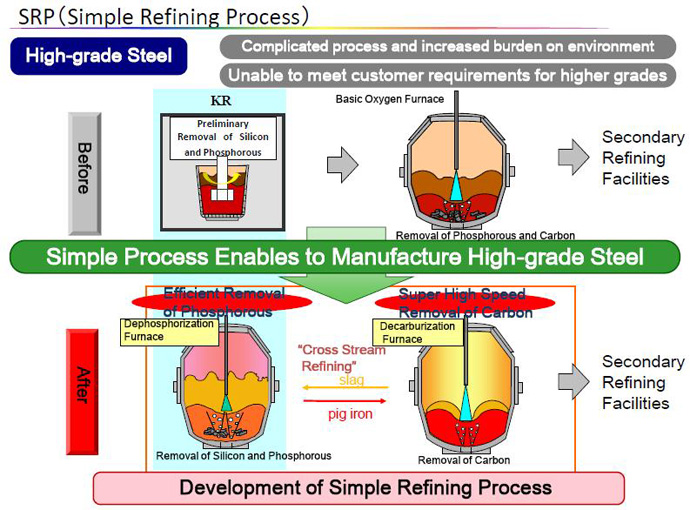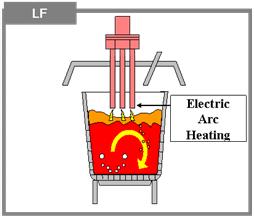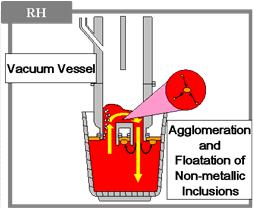Sumitomo Metals Group Completes Investments in Innovative Steelmaking Process
2010.10.22
- Sumitomo Metal Industries, Ltd.
- Sumitomo Metals (Kokura), Ltd.
Sumitomo Metals (Kokura), Ltd., wholly owned subsidiary company of Sumitomo Metal Industries, Ltd. (Sumitomo Metals), has been engaged in investing in innovative steelmaking processes and has finished the final stage of a dephosphorization furnace. A ceremony to celebrate completion was held today and operations have begun.
Investment for this purpose was first done at the Wakayama Steel Works of Sumitomo Metals. As its SRP (Simple Refining Process) has proved to be effective, leading to its adoption at Sumitomo Metals (Kokura), Ltd. Beside the SRP, Sumitomo Metals (Kokura), Ltd. has achieved improvement in quality competitiveness by complete separation of the manufacturing processes for two types of specialty steels: super clean steel (which contains extremely low non-metallic inclusions) and super functional steel (which performs functions controlled by non-metallic inclusions.)
The SRP process has two tasks, removal of phosphorous (dephosphorization) and removal of carbon (decarburization), to be carried out by two different converters. These substances are contained in the molten pig iron. Separate refining of the two substances under their optimal conditions enables achievement of three goals: quality enhancement (80ppm or less phosphorous impurities), higher efficiency (a blowing time of 9 minutes), and reduction in environmental load (significant reduction in slag and
CO2 emission). The SRP technology, that was introduced at Sumitomo Metals’ Wakayama Steel Works became the industry’s standard as innovative steelmaking technology, and received the Okochi Memorial Grand Production Prize in 2006.
The new dephosphorization furnace has also applied the SRP-Z process. In this process dephosphorization flux in a fine powdered form is blown onto the surface of molten pig iron, in order to lower the level of phosphorous content and expand production of high-grade steel. (Press released on October 20, 2010.)
Sumitomo Metals (Kokura), Ltd. carried out the investments in two phases. The first phase was construction of facilities for secondary refining (*1), namely, the No. 2 LF refining facility (*2) and the No. 2 RH degassing facility (*3), and the No. 4 continuous casting facility, which began operation in December 2009. The second phase was construction of a dephosphorization furnace, which has just been completed and has begun operation on this occasion.
Investments in innovative steelmaking process
| 1. | Total investment amount:27 billion yen | |
| 2. | Construction period | |
| First phase: | Construction of the 2LF, 2RH, and 4CC facilities from February 2007 to December 2009 | |
| Second phase: | Construction of a dephosphorization furnace from February 2007 to October 2010 | |
| Features: | ||
| ・ | Complete separation of manufacturing processes for super clean steel and super functional steel through construction of the new 2LF, 2RH, and 4CC facilities. |
|
| ・ | Introduction of the SRP through construction of a dephosphorization furnace | |
<Reference>
1. Completion ceremony
(1) Time and date: Starting at 11:00 a.m. on Friday, October 22, 2010
(2) Ceremony organizer: Yoshimitsu Kato, President of Sumitomo Metals (Kokura), Ltd.
(3) Attendees:
Approximately 100 people including the Mayor of Kitakyushu City; representatives of construction-related companies; labor union representatives; representatives of affiliates; Hiroshi Shimozuma (Chairman) and Hiroshi Tomono (President) of Sumitomo Metal Industries; and the president and other directors of Sumitomo Metals (Kokura)

<Glossary>
| *1 Secondary Refining The steel refining process is divided into two categories: primary refining, which is designed to remove carbon from molten pig iron, and other refining processes conducted after the primary refining, which are collectively called secondary refining. Secondary refining removes impurities and adjusts elements. Secondary refining usually takes place in the ladle, a transportation vessel for molten steel. It is very important for the production of high-grade steel. Examples include LF and RH. |
||
| *2 LF (Ladle Furnace) A secondary refining process whereby molten steel is heated in ladles using an electric arc. The LF process is effective in reducing sulfur and controlling non-metallic inclusions in molten pig iron. |
 |
|
| *3 RH (Ruhrstahl-Heraeus) The RH process is composed of a vacuum vessel and two tubes (suction tubes) immersed in molten steel in a ladle. The molten steel is sucked into the vacuum vessel through one suction tube at which point argon gas is injected. The molten steel then flows out back to the ladle through the other suction tube. This process enables continuous vacuum-treatment of molten steel in a ladle. During the RH refining process, degassing and intensive stirring take place in the vacuum vessel. This facilitates agglomeration of non-metallic inclusions, which then float to the surface. This process is therefore effective in reducing non-metallic inclusions. |
 |
|
